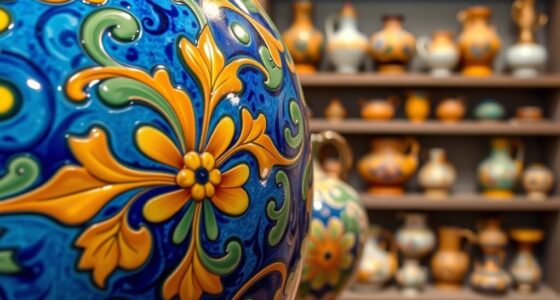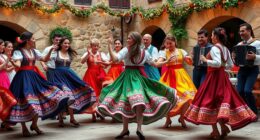You can see the Etruscan civilization’s influence in Italy today through their art, architecture, and language, which helped shape early Italian identity. Their skilled craftsmanship and architectural styles laid the groundwork for Roman traditions. Many Etruscan symbols and inscriptions continue to be part of Italy’s cultural history, enriching its heritage. If you explore further, you’ll discover how their centuries-old legacy still echoes in Italy’s modern cultural landscape.
Key Takeaways
- Etruscan art and architecture laid foundational elements for Italy’s cultural and architectural heritage.
- Etruscan language influenced Latin, shaping Italy’s linguistic development.
- Etruscan religious and social practices impacted early Roman cultural and spiritual traditions.
- Etruscan craftsmanship and artistic styles inspired later Italian art and sculpture.
- Etruscan archaeological sites and artifacts continue to deepen Italy’s understanding of its ancient origins.

The Etruscan civilization, which thrived in Italy from around the 8th to the 3rd century BCE, left a lasting mark on the country’s cultural and historical development. As you explore Italy’s rich heritage, you’ll notice the echoes of Etruscan influence in art, language, and architecture. Etruscan art, especially, provides a vivid glimpse into their society’s values, beliefs, and daily life. You might find yourself captivated by intricate frescoes, bronze sculptures, and tomb paintings that reveal their craftsmanship and aesthetic sensibilities. These artworks often depict scenes of banquets, mythology, and the afterlife, highlighting their focus on both the spiritual and the social. When you visit ancient sites or museums, you’ll see how their art combines realism with stylized patterns, setting the stage for later Roman artistic traditions. The detail and vibrancy of Etruscan art continue to inspire modern artists and historians alike. Additionally, ongoing excavations and research help uncover more about their archaeological record, shedding new light on their history and culture.
Equally significant is the Etruscan language, which remains a puzzle that fascinates linguists and archaeologists. Though much of it is still undeciphered, you can trace its influence through the few inscriptions and texts that have survived. These inscriptions, often found on tombs, pottery, and monuments, offer essential clues about their society, beliefs, and interactions with neighboring cultures. As you study Etruscan language, you’ll realize it was a distinct tongue, not directly related to Latin or Greek, but it played a fundamental role in shaping early Italy’s linguistic landscape. Some words and names from the Etruscan language persisted into Latin, and through Latin, into modern Italian. You may not speak Etruscan today, but understanding this language deepens your appreciation for the complexity of Italy’s ancient roots. It helps you see how the Etruscans contributed to the development of early Italian identity, and how their cultural remnants continue to influence Italy’s modern identity.
Frequently Asked Questions
What Were the Primary Religious Beliefs of the Etruscans?
You learn that the Etruscans believed in an extensive divine pantheon, with gods governing various aspects of life and afterlife. Their funerary rituals, which included elaborate tombs and offerings, reflected their focus on the journey to the afterlife. They honored gods like Tinia, Uni, and Menrva, emphasizing the importance of divine favor, life after death, and maintaining harmony between humans and gods in their religious beliefs.
How Did Etruscan Art Influence Renaissance Italy?
Etruscan art profoundly influenced Renaissance Italy by inspiring artists with their funerary art and temple architecture. You can see this impact in the detailed frescoes and sculptural techniques that Renaissance artists adopted, emphasizing realistic human figures and vibrant storytelling. Etruscan temple architecture, with its use of arches and terracotta decoration, also inspired Renaissance building designs, blending classical elements with innovative craftsmanship that shaped Italy’s artistic heritage.
Are There Any Etruscan Descendants Today?
You might be surprised, but there are no direct Etruscan descendants today. The Etruscan genetic legacy has largely blended into Italy’s population over centuries, making their true descendants virtually invisible. However, some scholars believe that certain Italian families and regions still carry traces of Etruscan culture, acting as silent cultural descendants. So, while no direct line exists, echoes of their legacy quietly persist in Italy’s DNA and traditions.
What Language Did the Etruscans Speak?
You’ll find that the Etruscan language remains largely undeciphered today. Scholars have studied Etruscan inscriptions extensively, but much of their language still puzzles us. The Etruscan language was unique and different from Latin or Greek, and the inscriptions offer valuable clues, yet they haven’t provided a complete understanding. So, while the language is known through inscriptions, much about it continues to elude modern linguists.
How Did Etruscan Society Compare to Greek City-States?
You see, comparing Etruscan society to Greek city-states is like comparing apples to oranges. Etruscans had a more unified political structure, with a confederation of city-states led by a supreme ruler, unlike the independent Greek city-states. Their social hierarchy was also more centralized, with aristocrats at the top and commoners below. This structure fostered stability, but lacked the democratic spirit that defined Greek city-states.
Conclusion
As you explore Italy’s rich past, you’ll see how the Etruscans left a lasting mark on its culture, architecture, and traditions. Their influence is woven into the fabric of modern Italy, like threads in a tapestry that tell a story of ancient ingenuity. Though centuries have passed, their legacy still echoes in your everyday life, reminding you that history isn’t just in books—it’s alive and kicking beneath your feet, shaping the Italy you know today.









